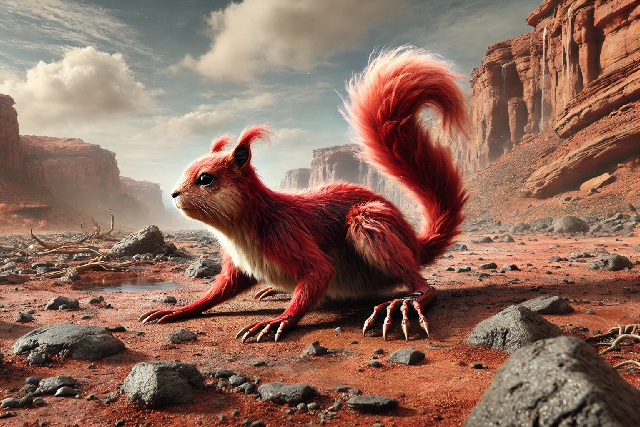As humanity sets its sights on Mars, the dream of transforming it from a barren desert into a thriving world full of life doesn’t seem so far-fetched anymore. Terraforming Mars—slowly altering its atmosphere, temperature, and environment to make it more hospitable for life—is an ambitious goal that could take thousands of years. But once we’ve created a livable ecosystem, the next question is: what animals could call Mars home?
In this post, we’re imagining the fascinating possibilities of what Earth animals might look like in their Martian forms, what they might eat, and which ones could thrive in this strange new world.
Life on Mars: The Challenges
Before we imagine the new Martian wildlife, let’s think about what makes Mars so different from Earth. The Red Planet has:
- A thin atmosphere (mostly carbon dioxide)
- Lower gravity (about 38% of Earth’s gravity)
- Colder temperatures (averaging -80°F, but with wide swings)
- Weaker sunlight (due to its distance from the Sun)
Any species we bring to Mars would need to adapt to these conditions over time, evolving to fit their new environment. Animals that are highly adaptable and resilient on Earth are the most likely candidates to evolve successfully in the Martian ecosystem.
1. Rodents (like rats or squirrels)
Rodents are highly adaptable, thrive in diverse environments, and are capable of quick evolutionary changes. Over millennia, Martian rodents might develop to take advantage of the lighter gravity and thinner atmosphere, perhaps becoming more agile and possibly evolving adaptations for the colder climate.
Speculative Name: Marskurl
This could be a squirrel-like creature with a gliding membrane to help it navigate in low gravity, and claws capable of leaping great distances.
Diet:
The Marskurl would likely feed on hardy Martian vegetation, such as specially engineered grasses, shrubs, and possibly small fruits or seeds adapted for Mars’ climate. Like Earth squirrels, they might be adept at foraging for seeds and storing food for colder seasons. Their diet could also include nutrient-rich fungi that we introduce to Mars to help build the soil.

2. Insects (like beetles or ants)
Insects are among Earth’s most resilient creatures, able to survive extreme conditions, and would likely play a crucial role in developing a Martian ecosystem. They might evolve to better process any new vegetation introduced or adapt to the soil’s different composition.
Speculative Name: Ferribeetle
A beetle-like insect that has evolved a tough, iron-rich exoskeleton to withstand Mars’ harsh environment and radiation levels.
Diet:
Ferribeetles would likely be decomposers, feeding on organic matter like decaying plants or dead organisms. They might also play a role in breaking down tough plant material and returning nutrients to the soil, much like beetles and ants do on Earth. They could feed on the remains of plant roots, leaf litter, or even nutrient-dense moss and lichen that have been introduced to Mars.
3. Reptiles (like lizards)
Reptiles, particularly desert-dwelling species, are adept at surviving with minimal water and under fluctuating temperatures, making them prime candidates for Martian life. These creatures could evolve thicker scales or the ability to burrow deep underground to regulate temperature.
Speculative Name: Redscale
A lizard-like creature with reddish scales, designed to blend in with the Martian soil, and a slow metabolism suited for long periods of dormancy during extreme cold.
Diet:
The Redscale would likely be a carnivore, feeding on insects like the Ferribeetle or small rodents such as the Marskurl. Like desert-dwelling reptiles on Earth, it would probably conserve energy by lying in wait for its prey, relying on efficient hunting techniques. It might also eat any introduced small animals that evolve in Mars’ ecosystem, filling the niche of a small predator.

Creating a New Ecosystem
Of course, this is all speculative. The exact path of evolution on Mars depends on a range of factors, including what plants and microorganisms are introduced, how the planet’s atmosphere and climate change over time, and what animals we choose to bring. However, thinking about these possibilities gives us a glimpse into a future where Mars is not just a barren wasteland but a living world, shaped by both human ingenuity and the natural adaptability of life.
One thing is certain: if we do terraform Mars, the animals that evolve there will be uniquely Martian, different from anything we’ve seen on Earth. They’ll represent a blend of Earth’s biology and the harsh, alien conditions of the Red Planet—a truly fascinating future to imagine.
Final Thoughts
As we take our first steps toward becoming a multi-planetary species, it’s thrilling to think about the life we might one day share our new home with. From the nimble Marskurl to the armored Ferribeetle and the resilient Redscale, the animals of a terraformed Mars could become icons of human exploration and evolution. The future of life on Mars is a fascinating concept to imagine, with endless possibilities for how Earth’s creatures might adapt to this alien environment.
Until next time, GertieBlu









